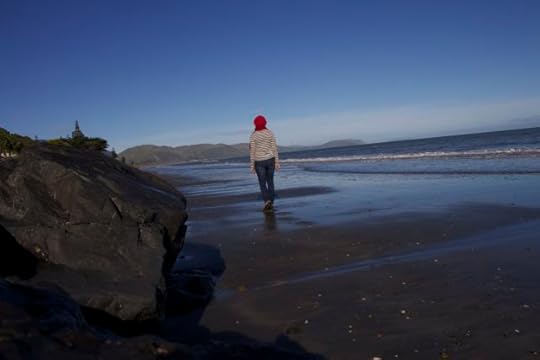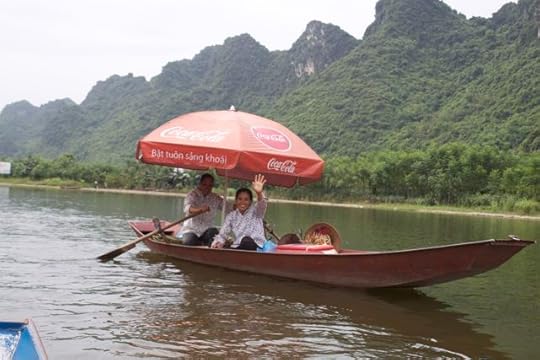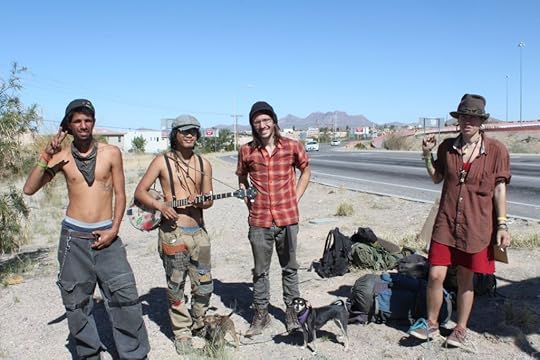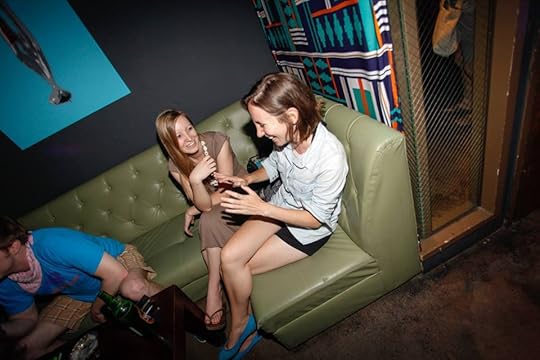Rolf Potts's Blog, page 57
August 6, 2013
Anything worth doing hurts: lessons from a long walk
Vagablogging :: Rolf Potts Vagabonding Blog
Twenty two kilometers is a good hike. It’s not a full day’s walk, by any means, but it’s a solid start at a leisurely pace. After a month in Paraparaumu it seemed the perfect way to honor the Kapiti Coast and thank her for the gift of rest, recuperation, and peaceful joy. To walk is to pay careful homage, one footstep at a time, to a landscape, and to give the world back the very thing she gave us: life.
It was at my first break that I realized there was a problem. I felt a slight pinch along the outside of both of my big toes. By lunch my toes were tender with each step.
About an hour before I got to Pukerua Bay I seriously considered calling my husband and asking him to pick me up. But then, my determination won out over common sense and in my characteristic, bull headed manner, I decided to finish the task at hand and do what I’d set out to do. One of the things I’ve learned over the years is that there is always a point in any adventure that you just want to quit. It hurts. Your heart fails. You question your own ability. It seems as if it’s not worth it to follow through. I’ve also learned that those difficulties can be pushed through, passed over, and the hardships borne, and the victory of accomplishing the hard thing is always worth the passing pain. So, I kept walking.
Days later, I was still paying the price. My feet were in bad shape. I had matching 2×1 cm blisters on the outside of my big toes. My pinkie toe on my left foot was swollen like a sausage. The tips of my toes were so sore that I could barely stand to wear socks… this was fully two days after my walk. Three weeks later and I’ve got blood blisters, black, beneath four of my toenails, pushing up in such a way that I’m worried about losing the nails.
Tony asked me the next day, after I teared up from banging my toes into a cabbage that was rolling around on the floor of the camper, “So, was it worth it?”
Of course it was worth it! I had a fantastic day. It was a walk, and an adventure that will live in my mind forever. The blisters will pass, the toenails will regrow if I lose them. The memories will last forever.
Here’s the thing: Anything worth doing, hurts. Several times a week I get emails from folks who express envy, or their desire to do some of the things that we get to do, traveling as a lifestyle.
The reality is, most people aren’t willing to push through the hard spots. They call in their safety net the moment it gets tough. They aren’t willing to do without or give up the things they would have to in order to get the postcard moment they want from my world. Dreams come with a cost. If you want to live epically, if you want to do the big things that you dream of, that will pull you out of your status quo and into something bigger and more authentically “you,” it’s going to cost you. If you’re feeling the angst of midlife and asking, “Wasn’t there supposed to be more than this?” The answer is yes… but it won’t be comfortable. The status quo is easy because it is comfortable, it doesn’t hurt that much. If you want your dreams, you can have them, but you’ll have to work, you’ll have to push, and you’ll have to learn how to suffer.
That’s what I spent the second half of my walk thinking about. It was worth every step.
You can read the whole story here
What are you doing (have you done) that hurts, but is worth it?
Original article can be found here: Anything worth doing hurts: lessons from a long walk
August 4, 2013
In making us less insular, travel makes us more creative
Vagablogging :: Rolf Potts Vagabonding Blog
“The same details that make foreign travel so confusing — Do I tip the waiter? Where is this train taking me? — turn out to have a lasting impact, making us more creative because we’re less insular. We’re reminded of all that we don’t know, which is nearly everything; we’re surprised by the constant stream of surprises. Even in this globalized age, slouching toward similarity, we can still marvel at all the earthly things that weren’t included in the Let’s Go guidebook, and that certainly don’t exist back home.”
–Jonah Lehrer, Why We Travel, Panorama Magazine (December 2009)
Original article can be found here: In making us less insular, travel makes us more creative
July 30, 2013
5 Ways not to look like a newbie traveler
Vagablogging :: Rolf Potts Vagabonding Blog
There’s absolutely nothing wrong with being a first-timer, a travel newbie; everyone has a first time and there is a sweetness in that first trip that you’ll spend the rest of your life trying to recapture. The lessons you learn and the experiences you have will shape your life and your adventures to come and those are things to celebrate and embrace.
There is no shame in being a newbie. There is, however, a little danger in it and perhaps good reason not to advertise the fact. The road will be a little smoother for you if it’s not obvious that this is your first rodeo and you’ll have less of a target painted on your back if you avoid some of the more obvious “I’m a brand new traveler” advertisements.
If you’ve been around a bit, you’ll recognize yourself or your friends in some of these, no doubt. Don’t get offended, we all want to save the next guy the hassle, right?
1. Don’t Travel With A New Bag
My Dad’s sage wisdom for travel is this: Look like you have less than everyone else. This might be impossible a lot of places, but you can look like you have less by traveling with an old, used pack, or scuffing up the new one before you go. Buy a used pack and put the extra money towards your travels. As an added bonus, you’ll be less attached to it. If you already bought the new pack, sew some patches on it even if it doesn’t need it, rub it on the sidewalk and scuff the seams, take a pencil or a marker to it and mark it up a bit.
2. Don’t Wear Your Money-Belt On The Outside
The point of a money-belt is to hide the fact that you’re carrying valuables. If it’s hung around your neck on the beach, you’re advertising. Instead, carry your money in pockets that zip closed or purchase one of those cool, traveler waist packs that you find abroad that are out of some native fabric and have zippered pouches with buttoned overlays. If you must carry wads of extra cash and valuables with you when you’re out and about, do so more discretely, by using one of the fake battery safes, with a screw off bottom, instead. You’re much less likely to have a “spare battery” stolen off of your person than you are a money-belt swinging in the wind.
3. Don’t Buy The “Hanoi Backpacker’s Hostel” T-Shirt
Or if you do, at least don’t wear the damned thing in Hanoi. Nothing says, “This is my first rodeo,” quite like actually buying (and wearing) the t-shirt. Take it home, wear it in Kansas, it will look exotic there. Over here, it’s painting a target on your ass.
Of course you stick out when you visit a culture that is not your own; that’s the whole point. But you can fly below the radar of the pirates who prey on travelers by wearing clothes that don’t advertise that you’re a tourist and have been in town five seconds. If you’re lucky, you’ll be mistaken for a long term traveler, or an expat, or someone who is not traveling through with tons of money to spend on t-shirts!
4. Don’t Ask Stupid Questions
I’ve offended you already, haven’t I? Your Mama was right, there are no stupid questions. But there are questions that are unnecessary and will mark you as a first timer for sure. It’s impossible to list all of these, but this is what defines a stupid question in a given context: Its answer can be found without words if you will just pay attention.
Think about this for a second: What separates a tourist from a quasi-local? The need for directions and to have questions answered, right? If you know a place you don’t need to ask questions. Who do the pirates target? Mainly those who don’t know a place. There’s no shame in not knowing a place, I live my whole life in places I don’t know, but there’s no need to advertise the fact and put yourself at unnecessary risk.
What to do instead: Slow down, be cool, shut up and listen, use your eyes and do your homework. There will be signs. If there are no signs, there will be people to follow. If there are no people to follow then use your intuition and move in a likely direction. There are times to ask questions, even obvious ones, but don’t be the first guy rushing to ask, be the guy who tries to suss out the answer on his own first. Every teacher will tell you that finding the answer to a question through doing is a better way to learn than simply being given the answer.
5. Don’t Carry Your Guidebook
Guidebooks are great, for pre-game research and post-game toilet paper. They have no business in your hands on the street (and for god’s sake don’t take one from your local library with the bar code stickers on the outside). I know there are people arguing this point before they even get to the end of the paragraph. Are there exceptions? Yes, of course; there are always exceptions! By all means, carry that guidebook into the ancient ruins site so you can read the descriptions of each temple complex. The point I’m making is this: you don’t want to be the guy walking down the Champs Elyse with his nose buried in the guidebook. You can read about Paris from anywhere in the world, when you are actually in Paris stop reading, and be there.
What have I missed? What else can you do to avoid looking like it’s your first rodeo?
Original article can be found here: 5 Ways not to look like a newbie traveler
July 28, 2013
Pilgrimage has always mixed obligation with novelty and adventure
Vagablogging :: Rolf Potts Vagabonding Blog
“In medieval times, when life was so narrowly circumscribed, religious pilgrimage was pretty much the only excuse a claustrophobic peasant had to leave his or her stupid little village, so a pilgrimage was an exercise in novelty and adventure under the banner of obligation; now, so many of us feel so surfeited with choice, the idea of pilgrimage has gained appeal as an exercise in obligation under the banner of novelty and adventure. The whole thing only works if you’re operating under the assumption that you’re doing this because you feel like you have to, like there will be some dire consequences if you cheat and take a bus. Of course there aren’t any such consequences, but the point is to play by the rules.”
–Gideon Lewis-Kraus, interview with Frank Bures, World Hum, 4/25/12
Original article can be found here: Pilgrimage has always mixed obligation with novelty and adventure
July 25, 2013
Central Asia Film Event in Toronto
Vagablogging :: Rolf Potts Vagabonding Blog
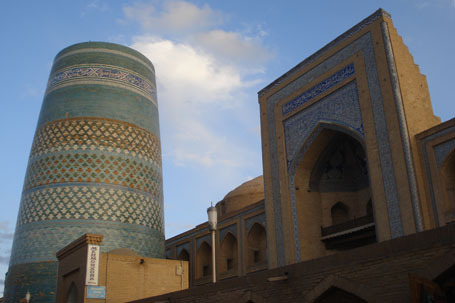
Khiva, Uzbekistan
I know it’s pretty last minute, but so is life, at times 
If you are in or around Toronto this weekend, you may be interested in checking out Sonchy’s Silk Road Adventure Central Asian Film Event.
Michael Soncina is trying to get some attention on a very adventurous part of the world to travel by organizing this festival. His aim is “to showcase the Central Asian region to a wide audience with the hope of increasing tourism to the area and its projects“. Having traveled and loved the region myself, I can only recommend this event to all those Vagabonding readers who happen to be in and around Toronto this weekend.
The main festival event will be the screening of a series of movies, whose titles are definitely intriguing:
Buzkashii! • The Light Thief • Desert of Forbidden Art • Buddhas of Mes Aynak • Boxing Girls of Kabul • Lonely Planet’s ‘Globe Trekkers’ Silk Road Series • Buzkashi Boys
“Buzkashi”, for all those who are unfamiliar with the term, is a sort of polo played using a headless goat’s carcass as “ball”… and that’s where you will start loving Central Asia!! be there, or start saving up for your own Central Asian adventure!
Original article can be found here: Central Asia Film Event in Toronto
July 23, 2013
A serious question: Why do you travel?
Vagablogging :: Rolf Potts Vagabonding Blog
I have a serious question this week. It centers around our motivations for travel. I’ve been asking this question a lot lately and am really intently listening for answers.
Why do you travel?
No really, not the surface, “I need a break, I wanna see something different,” answers.
WHY do you travel?
What does it do for you?
For those of you who’ve been at it for years, why do you keep going back to it?
For those who are just planning your first journeys, what is drawing you?
Why would someone leave comfort, safety, and ease for discomfort, risk and constant challenge?
“The wish to travel seems to me characteristically human: the desire to move, to satisfy your curiosity or ease your fears, to change the circumstances of your life, to be a stranger, to make a friend, to experience an exotic landscape, to risk the unknown..”
― Paul Theroux, The Tao of Travel: Enlightenments from Lives on the Road
Incidentally, I agree with Theroux in this, that the desire is characteristically human, it’s the layers of why that bear examining, for me. I’ve got a great interest in uncovering my own reasons, but I’ve also got an insatiable interest in your reasons.
What is it that drives us as a subset of humanity, as travelers to keep walking?
Tell me. I’m listening.
Original article can be found here: A serious question: Why do you travel?
July 21, 2013
The first and best instruments are the traveler’s own eyes
Vagablogging :: Rolf Potts Vagabonding Blog
“[Percy] Fawcett was taught not just how to survey but how to see — to record and classify everything around him, in what the Greeks called an autopsis. There were two principal manuals to help him. One was Art of Travel, written by Francis Galton for a general audience. The other was Hints to Travellers, which had been edited by Galton and served as the Society’s unofficial bible. The 1893 edition stated, “It is a loss, both to himself and others, when a traveller does not observe.” The manual continued, “Remember that the first and best instruments are the traveller’s own eyes. Use them constantly, and record your observations on the spot, keeping for the purpose a notebook with numbered pages and a map… Put down, as they occur, all important objects; streams, their volume, colour; mountain ranges, their character and apparent structure and glaciation, the colour and forms of the landscape, prevalent winds, climate. …In short, describe to yourself at the time all you see.”"
–David Grann, The Lost City of Z: A Tale of Deadly Obsession in the Amazon (2009)
(2009)
Original article can be found here: The first and best instruments are the traveler’s own eyes
July 18, 2013
When You’re Out of Loot in London
Vagablogging :: Rolf Potts Vagabonding Blog
Let’s face it: It’s summer and you’re broke. If you’ve somehow managed to make it to Europe and have some money for food and shelter, you might not have cash for much else. Trust me, I’ve been there. Everyone knows activities in places like London, for example, is pricey. But it’s important to know that there are several fun and interesting things to see and do that are completely free.
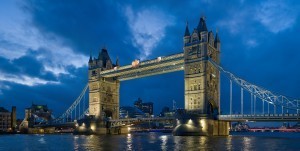
London Bridge is always free, and always majestic.
With that in mind, this is the first in a series focusing on free sights and activities in some of Europe’s best cities.
Taking the London example, here’s just a short list of free activities that give you a good taste of that amazing city:
-The National Gallery is free, although that may surprise many. Yes, one of the world’s great art museums—hosting works by world-renown masters—does not charge for entry.
-Piccadilly Circus, the gateway to the West End, is a colorful sea of people—especially when the sun goes down and the neon lights wash over the surroundings. Great people watching.
-The Changing of the Guard at the palace is always a sight to behold. The military pomp has been tradition for centuries, epitomizing military precision.
-Regent’s Park includes the city zoo and a wildlife garden. An oasis of leafy tranquility in the heart of the metropolis.
-There’s also St. James’s Park, ringed by some of London’s biggest landmarks (Buckingham Palace and Whitehall) featuring gorgeous greens and a soothing lake when the Tube and the crowds drive you mad.

St. James’s Park
-Speaking of great urban parks, no list would be complete without mention of Hyde Park. Lots of open air festivals and concerts are held here, especially in summer. Amble on over and enjoy.
-The Tate Modern (free except for certain special exhibitions) hosts a dazzling array of modern art, if you’re into that sort of thing.

Tate Modern
-The rightfully revered British Museum is another world-class treasure trove of history that deserves your time. It’s a jaw-droppingly thorough survey of human civilization.
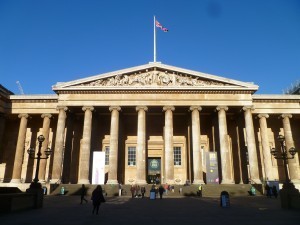
British Museum
Of course, the best parts of travel, meeting the people and sampling the culture, are always free—but having a list of other free stuff to do certainly helps.
Original article can be found here: When You’re Out of Loot in London
July 17, 2013
Vagabonding Field Report: Camping in Bergen, Norway
Vagablogging :: Rolf Potts Vagabonding Blog

Cost/day: Around $60 if you’re camping and buying cheap food at the grocery store.

What’s the strangest thing you’ve seen lately?
I don’t know how strange it is, but we saw lots of cute sheep all over the mountain tops that didn’t run away when we got close. My experience with sheep is that they like to keep a good distance from you at all times, but these didn’t seem to mind us being around. They just chewed grass and stared at us while I took their photo. Also, the fog over the mountain was quick moving and ominous looking.


Describe a typical day:
This was a quick weekend trip, so we packed light and planned to camp in the mountains. We were told that you can camp pretty much anywhere for free and it seemed to be true. Unfortunately, we had some rainy weather, and up on the mountain it was pretty cold. We ate bread, beans, cheese, and salami for breakfast/lunch/dinner. Most of our time was spent walking around the city sight-seeing and hiking around the top of Fløyen, then setting up our tent at night and doing our best to stay warm.


Describe an interesting conversation you had with a local:
Sadly we didn’t have the opportunity to hold any long conversations with any locals (we didn’t come across anyone else while hiking until we were near the bottom, and everyone was too busy power-walking to stop and talk). However, in the short conversations we had, I felt that everyone was very cheerful and friendly.


What do you like about where you are? Dislike?
It is beautiful here! Even in less than ideal weather. My big dislike is how expensive it is in Norway! These two 12oz local beers were $24 (plus tip), which is officially the most expensive beer I’ve purchased.
What new lesson did you learn?
Apparently there are cabins along the trails that are free and open for public use. This lesson would have been handy to learn before the trip was over, this way we could have been in a cabin instead of freezing cold and wet in a small tent with a pair of pants on my head to keep warm.
Where next?
You know where I really want to go? Madagascar or Socotra. I just need a travel buddy, so let me know if you’re up for it! More travel photos here!
Original article can be found here: Vagabonding Field Report: Camping in Bergen, Norway
July 16, 2013
Vagabonding field report: Finding the best-kept secrets in Busan, South Korea
Vagablogging :: Rolf Potts Vagabonding Blog
Cost/day: $50
What’s the strangest thing you’ve seen lately?
After haggling over a hat with a friendly saleswoman, I stumbled upon an alley where old women sat in plastic chairs, clutching their purses and negotiating currency exchange with passing foreigners.
Black market? Perhaps, but I don’t think even the police could rouse these women from their territory. They seemed cemented to those chairs.
Describe a typical day:
I take an intercity bus to Busan from my apartment in Changwon on Saturday afternoon. If traffic’s bad, the journey will take about two hours. I’m always armed with an iPod full of podcasts to pass the time.
Nampodong is Busan’s go-to district for gift shopping. Best visited in the day, this area offers everything from knockoff Coach bags to badly translated English shirts.

Armani knockoff sunglasses–and they even come with a fake Louis Vuitton case!
Shopping usually isn’t my preferred activity of choice, however. Luckily, Busan is dotted with temples and beaches for a change of scenery. Haedong Yonggungsa temple is worth a visit for its prime location on the rocks, overlooking the ocean.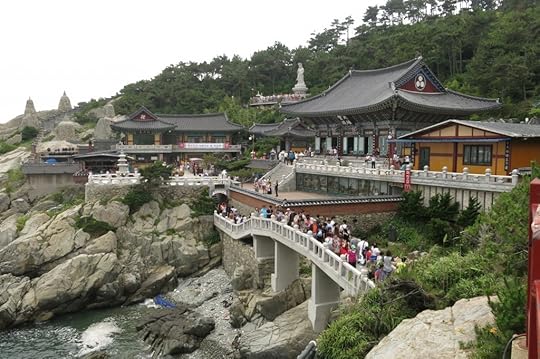
Dinner is barbecued eel. The waitress asks us to pick our dinner from the full fish tank of writhing eels. We turn the pieces on the grill in the middle of our table and dip them in salty, spicy bean sauces.
After dinner, I head to the Kyoungsung University area. This is arguably the best spot for Busan’s nightlife. My favorite place to dance, Almost Famous, is an intimate underground spot pumping out good electronic beats.
If I make it until daylight, Gwangalli Beach wins first prize for sunrise-watching.
What do you like about where you are? Dislike?
Busan offers so much in the way of foreigner-friendly activities (ahem, brunch, anyone?) while still maintaining the integrity of Korean culture. It’s the second largest city in Korea, and its access to beaches makes it one of my favorite places to visit on the weekend.
My biggest complaint about Busan is its traffic. What’s normally an hour journey took me over three hours one Saturday during the sand festival in Haeundae.
The field of red beach umbrellas at Haeundae beach can be rather unsightly, too.
Describe a challenge you faced:
Directions can be a little tricky. I have a basic grasp of Busan’s geography, but I still navigate most places by the subway lines and directions from friends. Businesses change so frequently in Korea that coming back to an old spot can look completely different from a few months prior.
Sometimes it can be a struggle to communicate with taxi drivers, too. Most speak no English, and I’m sure my Korean pronunciation is horrific. I asked a taxi to take me to Songjeong Beach–one of four beaches in Busan–and he told me he didn’t know what I was talking about.
What new lesson did you learn?
When I signed my teaching contract in Changwon, I knew I would be close to Busan. But I don’t think I anticipated just how often would I visit it on the weekend. I’ve learned to make the most out of my free time in Korea by getting away from the daily grime and grit of my neighborhood.
Where next?
I’ll take my summer vacation in Bali at the end of July. This will be my second solo trip, and I can’t wait to see the jungle paradise that is Indonesia.
Original article can be found here: Vagabonding field report: Finding the best-kept secrets in Busan, South Korea
Rolf Potts's Blog
- Rolf Potts's profile
- 323 followers


